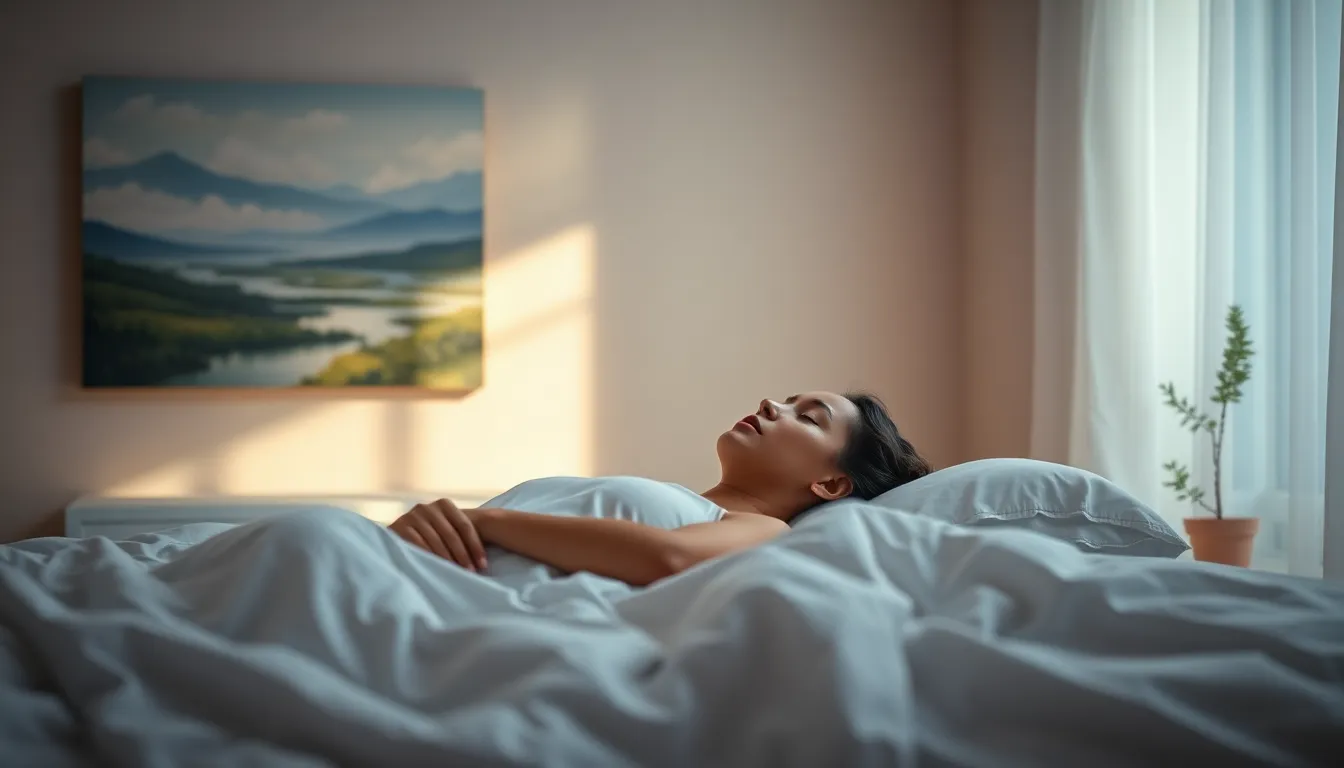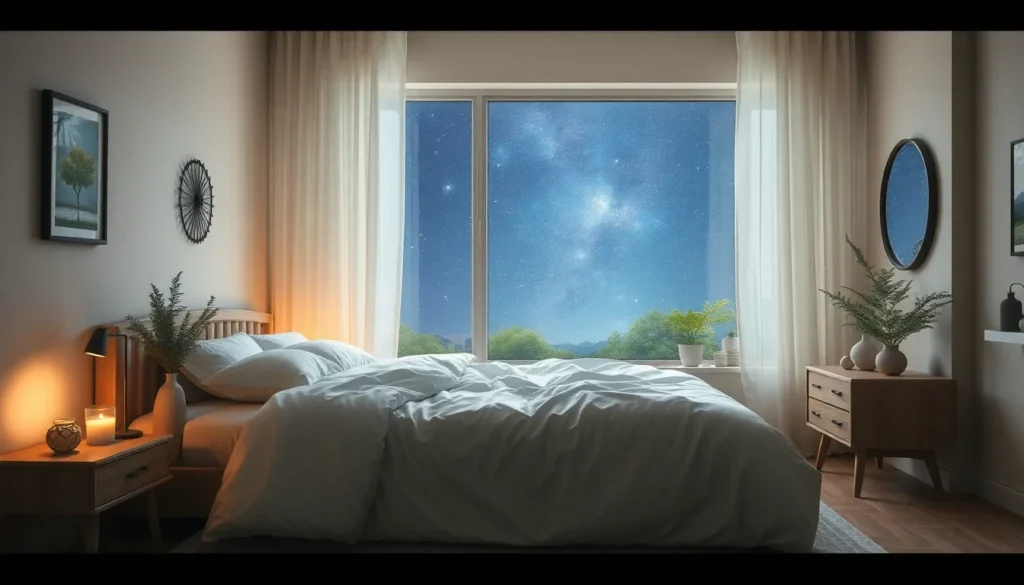Table of Contents
ToggleIn a world filled with distractions and stress, achieving a restful night’s sleep can feel like an elusive dream. Visualizations for sleep offer a powerful tool to calm the mind and ease the body into relaxation. By harnessing the power of imagery, individuals can create a serene mental landscape that promotes tranquility and prepares them for a peaceful slumber.
These techniques can help transform racing thoughts into soothing visuals, guiding the mind away from daily worries. Whether it’s picturing a serene beach or a tranquil forest, engaging the imagination can significantly improve sleep quality. As more people seek natural remedies for insomnia and restless nights, visualizations emerge as a simple yet effective solution to enhance overall well-being.
Understanding Visualizations for Sleep
Visualizations serve as a mental technique that encourages relaxation and prepares the mind for restful sleep. By engaging the imagination, individuals can cultivate a serene state that counteracts the stresses of daily life.
What Are Visualizations?
Visualizations consist of mental imagery exercises aimed at evoking calming scenes. Techniques often include imagining tranquil environments, such as peaceful beaches, lush forests, or serene mountain landscapes. By focusing on these vivid images, individuals distract themselves from intrusive thoughts, facilitating a smoother transition into sleep. Regular practice can enhance the ability to conjure these mental images, leading to improved sleep experiences.
The Science Behind Sleep Visualization
Numerous studies support the efficacy of sleep visualization in enhancing sleep quality. Research shows that visualizations can activate the parasympathetic nervous system, which induces relaxation and lowers stress levels. As the body relaxes, heart rate and blood pressure decrease, creating optimal conditions for sleep. Furthermore, a study published in the journal Sleep found that guided imagery significantly reduced symptoms of insomnia in participants. This evidence underscores the potential of visualization practices as a complementary approach to improving sleep health.
Benefits of Using Visualizations for Sleep

Visualizations offer significant benefits for promoting restful sleep, particularly by reducing stress and enhancing overall sleep quality. These techniques serve as effective tools for individuals seeking improved rest.
Reducing Stress and Anxiety
Reducing stress and anxiety through visualizations occurs by engaging the imagination in soothing imagery. This practice shifts focus away from stressful thoughts, allowing for a tranquil mental state. Studies, including those published in the journal Health Psychology, demonstrate that visualizations lower cortisol levels, which directly impacts stress reduction. By regularly incorporating visualization practices, individuals can build resilience against anxiety, leading to a more peaceful mind at bedtime.
Enhancing Sleep Quality
Enhancing sleep quality with visualizations involves creating mental scenarios that promote relaxation and comfort. Techniques such as guided imagery facilitate a smoother transition into sleep by stimulating the parasympathetic nervous system. Research in Sleep Medicine Reviews highlights that individuals who practice sleep visualizations experience longer sleep duration and improved sleep efficiency. Imagining calming landscapes or happy memories effectively distracts from racing thoughts, fostering a deeper, more restorative sleep experience. Proper implementation of these techniques results in a noticeable improvement in overall sleep health, directly benefiting physical and mental well-being.
Different Types of Visualizations for Sleep
Various visualization techniques can enhance sleep quality by promoting relaxation and reducing anxiety. This section explores specific methods to effectively utilize visualizations for restful sleep.
Guided Imagery Techniques
Guided imagery techniques involve picturing calming scenes or events while in a relaxed state. Practitioners may imagine peaceful settings, such as a serene forest or a quiet lakeside, while focusing on the details to immerse themselves fully. Incorporating specific elements, like gentle waves or rustling leaves, deepens the experience and enhances relaxation. Research demonstrates that guided imagery not only reduces stress but also fosters a sense of safety and comfort conducive to sleep. Utilizing audio resources, such as guided meditation recordings, can further assist in navigating these mental journeys.
Nature-Based Visualizations
Nature-based visualizations center on imagery from the natural world, capitalizing on the calming effects of nature. Individuals may visualize walking through a lush garden, lying beneath a starry sky, or hiking a tranquil mountain trail. Engaging with vivid sensory details, such as the scent of flowers or the sound of chirping birds, fosters a connection with peaceful environments. Numerous studies indicate that exposure to nature—whether real or imagined—can lower heart rates and promote relaxation, translating into improved sleep quality. Incorporating elements from these natural landscapes into one’s visualization routine can enhance the effectiveness of sleep techniques.
How to Implement Visualizations for Sleep
Implementing visualizations for sleep involves creating a suitable environment and integrating the practice into a nightly routine. Here are specific strategies to enhance the practice.
Creating a Sleep-Friendly Environment
Creating a sleep-friendly environment plays a crucial role in effective visualizations. Focus on the following elements:
- Lighting: Use dim lighting to signal the body it’s time to wind down. Soft, warm lights can promote relaxation.
- Temperature: Maintain a cool room temperature, ideally between 60°F to 67°F, to facilitate better sleep.
- Noise: Reduce noise levels with earplugs or white noise machines. These can mask disruptive sounds and create a more peaceful setting.
- Comfort: Invest in a comfortable mattress and pillows. Comfort directly influences the ability to relax and visualize effectively.
- Aromatherapy: Use calming scents like lavender or chamomile. Essential oils can enhance relaxation and support the visualization process.
Incorporating Visualization into Your Routine
Incorporating visualization into a nightly routine enhances its effectiveness. Follow these steps for optimal results:
- Set a Specific Time: Dedicate at least 10-15 minutes each night for your visualization practice to establish consistency.
- Choose a Comfortable Position: Lie down in a comfortable position, ensuring relaxation of the body to initiate the process.
- Focus on Your Breath: Begin with deep, even breaths to prepare the mind and body for visualization. This practice helps center thoughts and reduces distractions.
- Select Imagery: Choose calming scenes, such as a beach or forest, that resonate personally. Engaging with vivid details enhances the visualization experience.
- Avoid Distractions: Silence phones and limit interruptions. A distraction-free environment aids in deepening relaxation and focus.
- Be Patient: Allow the mind to wander and gently redirect focus back to the imagery. Consistency and patience enhance the effectiveness of visualization techniques.
By following these strategies, individuals can successfully implement visualizations into their sleep routines, contributing to improved sleep quality and overall well-being.
Visualizations offer a transformative approach to achieving restful sleep amidst life’s chaos. By tapping into the power of imagination, individuals can create serene mental landscapes that encourage relaxation and ease the mind. This practice not only helps in reducing stress and anxiety but also fosters a deeper connection to the natural world, enhancing overall sleep quality.
Incorporating visualizations into a nightly routine can be a simple yet effective strategy for those struggling with insomnia or restless nights. By dedicating time to engage in calming imagery, individuals can cultivate a more peaceful mindset, paving the way for restorative sleep. Embracing these techniques can lead to lasting improvements in sleep health and overall well-being.







